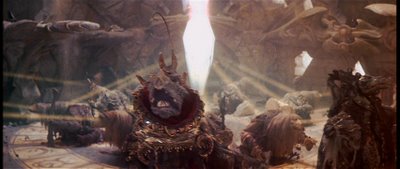
It took me a couple dozen years, but tonight I finally got around to watching The Dark Crystal (1982), the all-puppet fantasy movie co-directed by Jim Henson and Frank Oz and produced by Gary Kurtz. Interesting. I especially had fun spotting the story elements which reminded me of Return of the Jedi (1983) — the clothes that collapse after a character dies and his body vanishes, the person who falls down a deep shaft to his death — or, for that matter, of The Black Cauldron (1985), both of which actually came out later. The Chamberlain kept reminding me of Gonzo, though.
For the longest time, the only thing I knew about this story was that, back in the 1980s, a number of Christian commentators who were adamant opponents of “the New Age movement” would sometimes point to this film as a classic example of “New Age” thinking; just as Star Wars featured a vaguely pantheistic “Force” which had a “Dark Side” and a not-so-dark side, the theme of The Dark Crystal, supposedly, was that “good” and “evil” were opposite sides of the same coin and needed to be brought together.
But now that I’ve seen the film for myself, I’m not entirely satisifed with that reading. It seems to me that a more profitable take on the film might be that the Skeksis represent the body (i.e., physical or material reality), since they are frequently seen indulging their appetites, for food and power and so on; and the Mystics represent the soul (i.e., spiritual reality), since they are frequently seen going on a sort of pilgrimage or creating Buddhist-style mandalas with coloured sand or chanting like Tuvan throat-singers; and the fusion of these two creatures represents the need for unity between soul and body. On that level, one might almost say the film is very Christian, or at least somewhat incarnational.
Granted, the Skeksis are certainly more evil than the Mystics in the sense that they are selfish and genocidal; and the Mystics, by pursuing a spiritual path rather than a material path, and by willingly going to their consummation, seem more “good” in the sense that they seem to be more selfless and enlightened; and I for one certainly don’t have a problem saying that the spiritual realm is higher than the physical realm, inasmuch as God himself is Spirit and the physical realm depends for its entire being on him.
But for those of us who were meant to live in this meeting ground between the physical and spiritual realms, the separation of body and soul — which begins with our separation from the God who made both — is, itself, an evil. And so, I have no problem saying that the Skeksis and the Mystics needed to be reunited.
One possible objection to my interpretation of the film is that, once reunited, the UrSkeks (as the fused beings are known) seem to be even more ethereal or spiritual than the Mystics. And perhaps, in some sense, they are. But I am reminded of the stories we have about the resurrection of Jesus, when his soul and body were reunited in a way that went beyond mere resuscitation. Reportedly, he vanished in the blink of an eye and passed through locked doors as though they weren’t there; however, to prove his corporeality, he also ate a fish, possibly more than once.
So, the transcendent form taken by the UrSkeks is not all that big a problem to me. My question is, would they eat anything?
MAR 11 UPDATE: Here’s a strange and bizarre angle that just occurred to me: the body-soul dynamic in this film reminds me in some ways of Powell & Pressburger‘s Black Narcissus (1947), of all things. To quote what I blurbed elsewhere, four years ago:
Some people might want to dismiss this as one of those movies in which uptight European Christians are undone by the irresistible pleasures of exotic pagan sensuality, but it’s not as simple as that. One of the characters we see is a “holy man” who sits on the mountain and stares at the other mountains — never speaking, never moving, just staring, staring, staring — and one of the nuns remarks later on that there may be something about that part of the world that drives people to go to extremes; you either “ignore” your physical environment, including the impulses of the flesh, as the holy man does, or you “give yourself up to it”, as the sensualist, drinking, womanizing Farrar character does. Thanks to that line in particular, I came out of this film appreciating how my own faith, as a Christian, tries to bring the spirit and the flesh into some sort of balance, rather than veer fully to one extreme or the other.
For whatever that’s worth.













